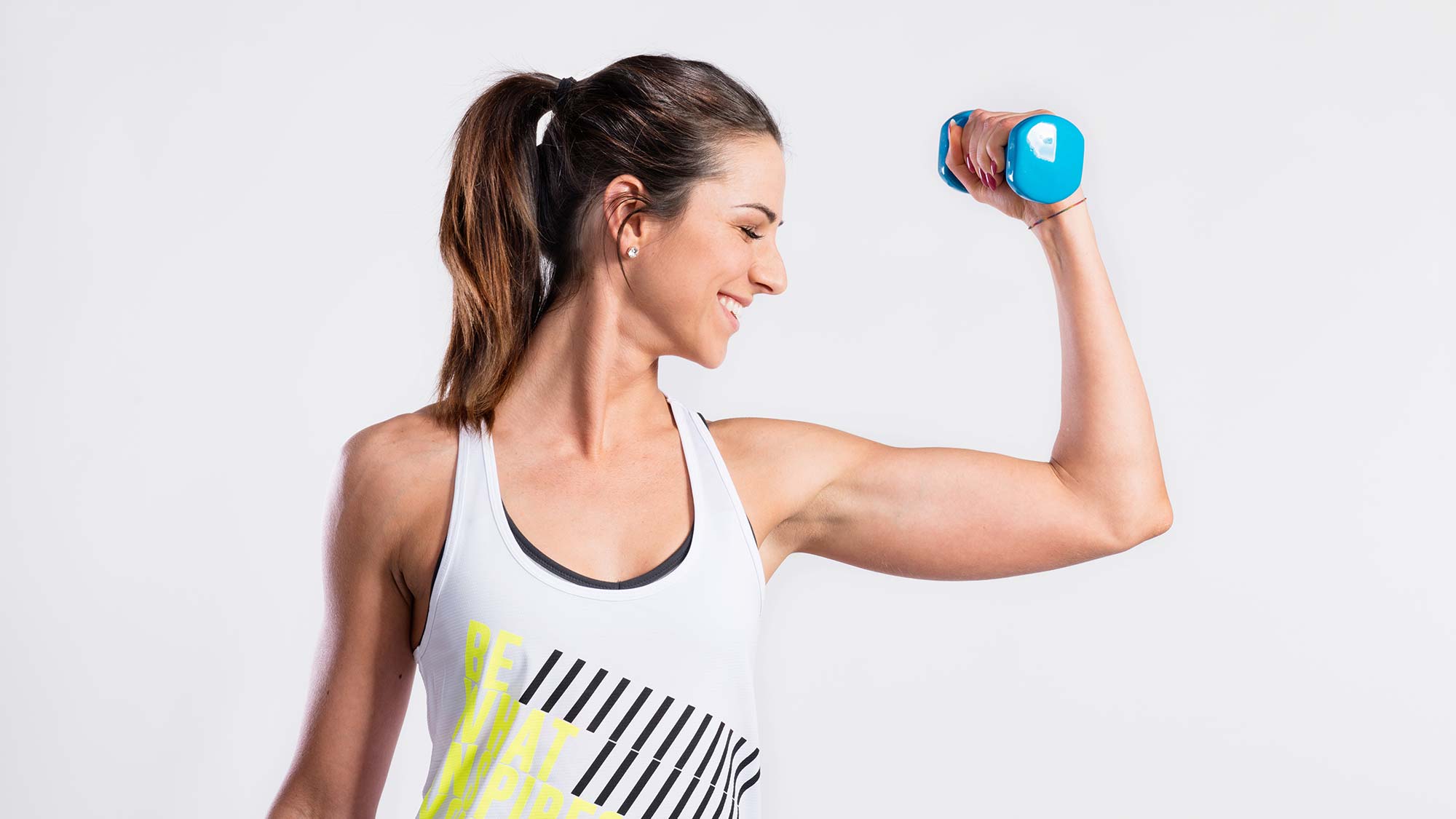3 of the best arm workouts with dumbbells

When it comes to the best arm workouts — ones that build strength, add muscle, and rev up your metabolism — there is no better tool than the good old-fashioned dumbbell.
There’s a reason everyone’s been buying dumbbells in droves while gyms remain off-limits — they’re one of the most versatile and affordable pieces of equipment you can own. They can be used to target major muscle groups or isolate the bis and tris (biceps and triceps, for the newly initiated). And importantly for city dwellers in cozy apartments, they take up a relatively small amount of space.
Plus, while we’re shaping our shoulders and defining our chests, we’re also unknowingly working on another important skill: Balance. According to a study presented in the Journal of Strength and Conditioning Research, participants who trained using free weights like dumbbells greatly improved their overall balance compared to those who trained using only fixed weight machines.
In fact, this full body dumbbell workout builds strength with just six exercises.
So break out those dumbbells and try these three killer arm workouts. Each workout is a “superset,” consisting of two complementary exercises paired together. Perform one exercise right after the other, with a brief rest after you’ve finished the set. Aim for 3-5 rounds of each superset, with 8-12 repetitions of each exercise. If you’re just getting started with dumbbell training, focus on one of these workouts a day. If you’re an expert, go for two or three in one training session. You’ll also find a few alternative exercises listed, with modifications or substitutions.
3 of the best arm workouts with dumbbells
Workout 1: Dumbbell chest press and dumbbell skull crusher
The chest press works multiple groups of muscles at once, making it an effective movement for increasing overall upper body strength. Here's how to perform the chest press.
- Take a dumbbell in each hand and lie down on a bench
- Make sure both feet stay firmly planted on the floor. Keep your spine neutral and your core engaged
- Bring both your arms out to the side, elbows bent and aligned slightly below the shoulder line, with your forearms perpendicular to your torso and your palms facing in front of you
- Lift both dumbbells above your chest, aiming them for right above your breastbone
- Squeeze your shoulder blades together and slowly return both weights to the starting position.
Skull crusher
Get instant access to breaking news, the hottest reviews, great deals and helpful tips.
While the violently named “skull crusher” doesn’t exactly evoke the most calming imagery, it’s a great way to target the triceps - a large muscle in the back of our arms.
- Start by lying on a bench, an exercise mat, or the floor
- Your spine should be neutral, and both feet should be planted firmly on the ground
- With a dumbbell in each hand, lift your arms so that the weight is directly above your shoulders
- Both palms should face inward. Keeping the elbow still and in line with your shoulder, slowly lower the dumbbells down towards your earlobes
- Squeezing the triceps, lower the dumbbells back to their original position.
Don’t have a bench handy? Use the floor press as a substitute. Lie flat on the floor or an exercise mat, with your knees bent and feet firmly planted. Perform the exercise as described above, pressing both dumbbells above the center of your chest, and returning them to the starting position with control.
Using two super heavy weights for the skull crusher has the potential to put strain on your elbow and shoulder joint. When you only have oversized dumbbells at your disposal, try a single dumbbell skull crusher. Hold the weight at the ends with both hands, aligned with the center of your chest. Slowly lower the weight towards the top of your head, keeping your elbows still and centered over the shoulder joint. Squeeze the triceps and bring the weight back to its original position.
Workout 2: One arm dumbbell row and dumbbell concentration curl
If you find yourself at a computer for hours a day, your posture might leave a lot to be desired. Sitting in front of screens causes our shoulders to protract (or round forward) and the muscles in our upper and mid back to lengthen and weaken. The one arm dumbbell row will help strengthen these areas.
Single-arm dumbbell row
Here's how to do a one arm dumbbell row.
- Place your left knee and your left hand on a bench, with your knee aligned under your hip and your hand aligned under your shoulder
- Keep your right foot on the floor, in line with your left knee. Ensure that your hips are square
- Flatten your back and brace your core. Take one dumbbell in your right hand, and line it up directly below the right shoulder
- Squeezing your right shoulder blade in towards the center of your spine, bend your right elbow keeping it close to the rib cage, and bring the weight in line with your torso
- With control, slowly lower the dumbbell back to its starting position. Finish 8-12 repetitions, then repeat on the other side.
Dumbbell concentration curl
The dumbbell concentration curl is great at getting us the bicep pump we crave. In fact, according to this 2014 study by the American Council on Exercise, the concentration curl elicited the greatest activation of the biceps brachii (a large muscle at the top front portion of our arm) over seven other bicep exercises.
- Begin in a seated position, either on a bench or chair, with your feet flat on the floor
- Bend forward at the hip, picking up a dumbbell from the floor in your right hand. Your right arm should be extended, with your right elbow pressed into your right thigh
- Squeeze your bicep and bring the dumbbell up towards your shoulder, keeping your arm braced against your thigh
- Lower the dumbbell slowly to the starting position. Repeat for 8-12 reps, and then switch to your left arm.
Don’t worry if you don’t have access to a bench. You can use a chair, the arm of your couch, or countertop to brace yourself with your non-working arm as you row with the other.
The standing bicep curl is a great alternative to the concentration curl if sitting or bending forward is an issue. Stand with your feet hip-width apart with a dumbbell in each hand. Your palms should begin facing inward, towards your body. Squeeze your biceps and begin to lift the weights, rotating your palms outward towards the wall in front you. Bring the dumbbells all the way up to your shoulders, with your palms facing inward towards your chest. Lower the weight back down to the starting position rotating your palms inward towards your hips.
Workout 3: Dumbbell overhead press and dumbbell reverse fly
Lift a heavy box to put on a high shelf and you’ll feel just how much work your shoulders have to do. Because the shoulder is one of the more unstable joints in the body, it’s important to make sure that the muscles surrounding that joint are strong.
- Start the dumbbell overhead press in a standing position, with your feet placed about hip width apart. Keep your spine neutral and your core braced
- With a dumbbell in each hand, bring your arms up to shoulder level, bend your elbows at a right angle, and face your palms to the wall in front of you
- Your arms should be in a “goal post” position. Slightly tuck the chin and press both dumbbells above you, aiming them directly above the crown of your head
- Keep the core engaged and don’t excessively arch your back. Slowly lower the dumbbells back down to the starting position.
Dumbbell reverse fly
While we’re on the subject, let’s take a look at another excellent exercise for shoulder strength and stability: the dumbbell reverse fly. This movement, sometimes referred to as the “rear delt fly” because it targets (you guessed it) the rear deltoids, is also excellent at strengthening the muscles of the back.
- Perform the fly by taking a dumbbell in each hand and hinging your hips back, aiming your tailbone to the wall behind you
- Brace your core and bring your torso nearly parallel with the floor. Keep your back flat - be sure to not round your spine
- Let the dumbbells fall directly below the shoulder joint, but don’t allow the weight to pull the shoulders forward
- With a slight bend in each elbow, squeeze your shoulder blades together and lift both of your arms to shoulder level
- Lower the dumbbells back towards the floor with a controlled tempo. Avoid “swinging” or using momentum to complete the range of motion.
If using both dumbbells at once causes pain in the shoulder, or you find it hard to press overhead without excessively arching your back, you can perform the press seated or drop a dumbbell and just press one. Grab the dumbbell at each end and press the weight overhead, aiming for the crown.
The “bent forward” position of the reverse dumbbell fly can be tough on the lower back, especially if you already experience pain, tightness, or injury in the area. An alternate option is the single arm dumbbell reverse fly. To begin, brace your left hand on the back of an upright bench or chair. In your right hand, take one dumbbell. Pitch forward slightly, engage your core and keep your back flat. With a small bend in the right elbow, Squeeze your right shoulder blade in towards your spine, raising the dumbbell to slightly below the right shoulder. Lower the weight back down towards the ground. As in the dumbbell reverse fly above, avoid using momentum to complete the movement or allowing the dumbbell to “swing.” Perform 8-12 repetitions, and then repeat on the other side.
More from Tom's Guide

Jennifer Rizzuto is a freelance writer and certified personal trainer based in Long Island, NY. She covers various fitness-related topics and reviews for Tom's Guide. She also writes sketch comedy and short films, and performs frequently as an actor, singer, and improviser. When she's not writing, working out, or performing, you'll find her trying to convince her husband to get a dog.
- Sam HopesFitness Editor and Coach










